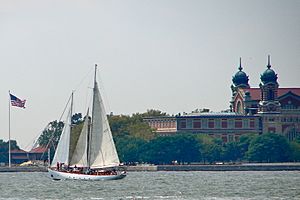Shearwater (schooner) facts for kids
The Shearwater is a cool wooden ship called a schooner. It's about 81.5-foot (24.8 m) long and is currently docked in Lower Manhattan in New York City, New York.
This schooner was designed by Theodore Donald Wells. It was built by the Rice Brothers Corporation in East Boothbay, Maine, back in 1929.
During World War II, the Shearwater was used by the United States Coast Guard. Its job was to patrol the waters and look out for German U-boats (submarines).
Later, in the early 1980s, the Shearwater sailed all the way around the world! It also worked as a floating lab for the University of Pennsylvania.
Today, the Shearwater is operated by Manhattan by Sail. It takes people on fun 90-minute tours of New York Harbor. It can carry up to 48 passengers. In 2009, the Shearwater was added to the National Register of Historic Places, which means it's an important historical landmark.
class="infobox " style="float: right; clear: right; width: 315px; border-spacing: 2px; text-align: left; font-size: 90%;"
| colspan="2" style="text-align: center; font-size: 90%; line-height: 1.5em;" |
|- | Designer: | Theodore Donald Wells
|}
How the Shearwater Was Built
The Shearwater is 81 feet 6 inches (24.84 m) long from front to back. It measures 64 feet 6 inches (19.66 m) on its main deck. The part of the ship that touches the water is 48 feet 3 inches (14.71 m) long.
This schooner weighs 36 gross tons. Its widest part, called the beam, is 16 feet 6 inches (5.03 m). The ship goes 10 feet (3.0 m) deep into the water.
The Shearwater has a special design called a "semi-fisherman type." This design was very popular in the early 1900s. The bottom part of the ship, called the keel, is made of strong solid oak wood. The main body, or hull, is made of yellow pine wood over an oak frame.
The inside support beams are also oak. The back part of the ship is made of layered mahogany. The decks where people walk are made of teak wood. The Shearwater has two tall masts made of spruce wood.
Below the deck, there is an engine room. It holds a Detroit 4-71 diesel engine.
The Shearwater's Journey Through Time
The Shearwater's designer, Theodore Donald Wells, was a very skilled ship architect. He started designing ships in 1902. He later worked for the United States Navy during World War I.
The Rice Brothers Corporation was famous for building beautiful yachts. They built about 4,000 ships over 64 years. The Shearwater's main structure, its keel, was started on January 4, 1929. About 40 workers helped build the ship.
The Shearwater was launched into the water on May 4, 1929. Its first captain was Leon Esterbrook. The first owner was Charles E Dunlap. The ship's first home was in Oyster Bay, New York.
On November 7, 1942, the Shearwater was taken by the government for World War II. It became part of the United States Coast Guard's Coastal Picket Patrol. The ship was painted gray and given the number CG 67004.
It was based in Little Creek, Virginia. Its job was to patrol the waters near the Chesapeake Bay and south towards Cape Hatteras. The Shearwater was originally a gaff rigged schooner. But during the war, its sails were changed to a Marconi rig.
In July 1946, the Shearwater sailed through the Panama Canal for the first time. In the late 1970s and early 1980s, it completed a two-and-a-half-year trip around the entire world.
In December 1971, the ship was given to the University of Pennsylvania. It was used as a research vessel for their Institute of Environmental Medicine. The Shearwater also worked as a charter yacht, taking people on trips.
The current owners bought the Shearwater in 2000. On the morning of September 11, 2001, the ship was hit by falling pieces from the World Trade Center. Luckily, it was sailed to New Jersey and was safe.
The Shearwater was officially listed on the National Register of Historic Places on March 9, 2009.
See also
 In Spanish: Shearwater (goleta) para niños
In Spanish: Shearwater (goleta) para niños
| History | |
|---|---|
| Name |
|
| Builder | Rice Brothers Corporation |
| Laid down | January 4, 1929 |
| Launched | May 4, 1929 |
| Identification | CG67004 (USCG) |
| General characteristics | |
| Tonnage | 36 gross tons |
| Length |
|
| Beam | 16 ft 6 in (5.03 m) |
| Draft | 10 ft (3.0 m) |
| Installed power | Detroit 4-71 diesel |
| Sail plan | Schooner |
| Capacity | 48 passengers |
|
Shearwater (schooner)
|
|
| Location | North Cove Marina, Manhattan, New York City, New York |
| NRHP reference No. | 09000135 |
| Added to NRHP | March 9, 2009 |







